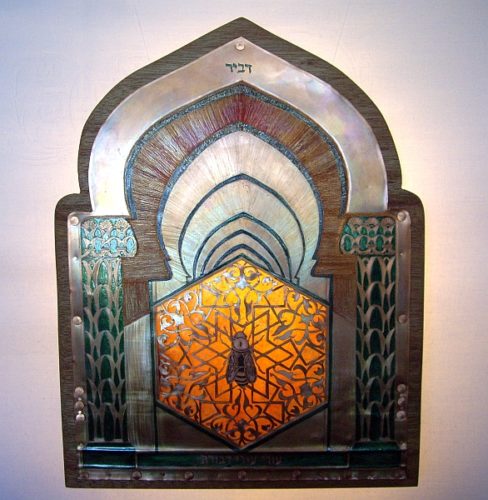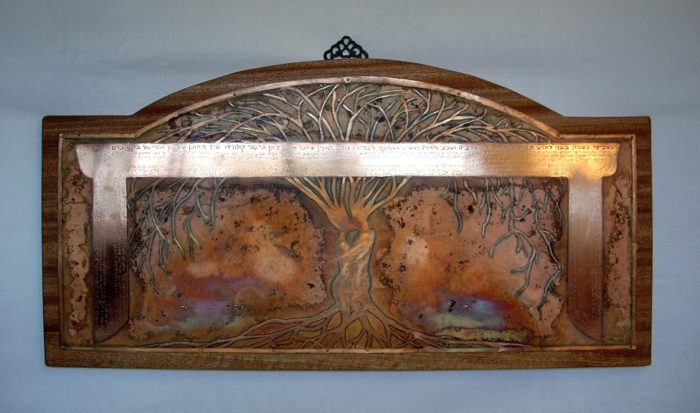Featured Artist: Shahna Lax, the Mystic in the Mountains
14 Feb2012
By Elke Reva Sudin, Edited by Dena Schupper
Divir and Devorah
Crestone, Colorado, is an hour from nowhere and not even equipped with high-speed Internet access, but it’s where Shahna Lax has made her home for the last 23 years. She lives a life without television, though in another life she used to be a tech serve for IBM. Shahna is a devout gardener and a contemporary artist who works in copper…and also considers herself a mystic who creates art with Judaic themes. What is her motivation? Shahna is interested in Hiddur mitzvah, the beautification of doing mitzvot, the concepts behind them, and not the sales of “Judaica.â€
Shahna was raised as a part of the Conservative movement, the daughter of Ben Jay Lax (one of the founders of camp Ramah, and University of Judaism in LA). Her father died was she was about 10. To describe her household, “[we were the types] to turn down the television to make Kiddush.†When she was 15, she tried to leave home (although she “idolized†her father) but left for good after graduating from high school at 17. In Israel, she “started at a kibbutz to get started and transferred to a university from there.†She studied Hebrew etymology and medieval commentary at Haifa University. Both studies would later inspire her copper work. When Shahna travelled to Crestone, she met a man at a Pesach seder who owned two lots in Crestone, one of which he had to sell within the week. She left her home in Santa Barbara, and used the opportunity to escape to the countryside.
Crestone is home to a large community of Buddhists; Shahna saw what she considered to be idolatry going on all around her. During a tour of “relics†(ashes from cremated Buddhist teachers) that came to Crestone, Shahna was invited to give a Jewish blessing for these remains during a program. “Everyone was sitting in a room–everyone in the room was either Jewish, or had names like Christine, all the wannabe Buddhists–that came for these remains.“ Shahna came home “really pissed†and was infuriated by the absence of commitment to “realizing the internal essence of divinity, instead [there was] this external crap.â€
“My work is my commitment and fidelity. In Hebrew we have avodah (worship). I recognize that the practice of it is a skill.†Shahna went on to create the series Toward the Higher Fidelity (2010), after being inspired by David White, a poet who revealed that holiness is a relationship, a marriage. “Traditional marriages, marriage to one’s work, and marriage to one’s self, if you can accomplish all three without compromising, then you can experience something beyond them.“
Shahna believes that “limitations lead to breakthroughs,†and incorporated that lesson, as well as the idea of marriage, in her copper work, Ketuba (2008). It was an almost impossible assignment because the father of the bride didn’t want to see the words (which is strange for an item that is important because of the text, not necessarily the decoration), and the bride wanted a tree design. Shahna was able to solve this by etching the text in the copper, so you only see it in certain lights, and incorporating a tree as an extreme landscape, since all trees grow short and wide (common knowledge for a mountain dweller).
She had no idea how to deal with the compositional limitations until she came up with a right to left, to back to right structure that went around, and suddenly she realized it was the form of the Hebrew letter chet. “Like a wedding chupah!†To accommodate the organic arches of the tree limbs Shahna made the limbs rise up above the chuppah before coming back around, which brought it away from the masculine rectangular form and formed it into a more feminine arch.
Shahna continued the expression of the holy place that is expressed through a symbolic (and feminine) form with her pieces, Divir and Devorah (2009). “In my circle in LA, friends and teachers, loved the word Divir–Asher biavodah bedivir beitecha, (“return your work to your houseâ€). We communicate just like bees doing the waggle dance–did you know that all bees that make honey are feminine? And the semetic languages all use the feminine forms for bee? As a gardener I feel very sensitive to that issue and to the vulnerability of what that means.†Divir and Devorah sold almost immediately.
Although she is living in a remote place, Shahna is following the Bat Kol. She thinks that the Baal Shem Tov would have a high regard for living in the mountains, near the great sand dunes, and high desert, immersed in nature.
For more of Shahna’s work visit http://www.studiomoresca.com/.
- In: Featured Artists
- Tags: Midwest US, Sculpture







